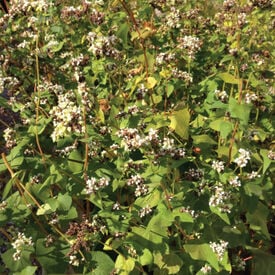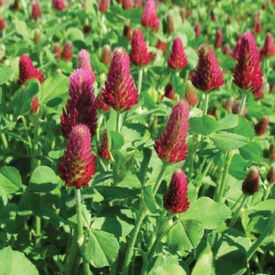The Common Buckwheat is a grain that can be planted late spring to early summer and improves top soil and an effective choke weed! This variety establishes quickly and matures in 60 days. This buckwheat accumulates phosphorus and and potassium for following crops and is frost sensitive. Buckwheat (Fagopyrum esculentum Moench): Cool Season, Grain, Annual, Upright growth habit, Enhances soil P availability,Crude protein: straw 5%, grain 13% Uses: Bees & Beneficial Insects, Green Manure, No Till, Organic Matter (Biomass), Weed Suppresion
The Crimson Clover is an attractive winter annual that can be planted fall or early spring and will protect and improve the soil. This good nitrogen fixer (70-150 lbs per acre per year) blooms showy crimson flowers in late spring that are an excellent source of nectar for bees. This variety inter-seeds well with grass, making it a great way to ready your vegetable garden for the spring or beautify a landscape! Not to be confused with the tough perennial clovers that can take over a meadow. Uses: Bees & Beneficial Insects, Chicken Forage, Compaction Control, Deer Attractant, Erosion Control, Forage, Green Manure, Nitrogen Fixation, No Till, Weed Suppression
Phenomenal cowpeas are a remarkable variety known for their impressive yield and versatility. These cowpeas produce robust, productive plants that are well-suited to a variety of growing conditions, making them a favorite among gardeners and farmers. Characterized by their large, green pods and high nutritional value, Phenomenal cowpeas offer a rich source of protein, fiber, and essential vitamins. The plants typically reach about 2 to 3 feet in height and can be grown both in garden beds and containers. They are valued for their resilience in hot and dry climates, which makes them particularly well-adapted to regions with challenging weather conditions. With a maturity period of around 70 to 80 days, Phenomenal cowpeas provide a generous harvest of flavorful, tender beans that can be enjoyed fresh, dried, or cooked in a variety of dishes. Their adaptability and high productivity make them a standout choice for both home gardeners and commercial growers.
The Big Boy Purplehull is a high yielding, popular Southern cowpea that is great for home gardens. Big Boy Purplehull is a long podded variety with 13-16 peas per pod that are light tan in color and oblong shape. This is a good garden variety and is very prolific. If you are using for Nitrogen fixation we highly recommend using a cowpea inoculant. Try with cowpea inoculant for maximum Nitrogen fixation.
The Quickpick Pinkeye cowpea is a bush type southern cowpea with early maturity and good disease resistance. This variety is a pinkeye Purplehull type variety that is determinate, erect, compact (reach about 20 inches), and non-vining. This cowpea gets its name, Quickpick, because it matures in about 60 days. The pods are dark-purple and about seven to eight inches long containing nine to eleven, kidney-shaped seeds with large, maroon colored eyes. If you are using for Nitrogen fixation we highly recommend using a cowpea inoculant. Try with cowpea inoculant for maximum Nitrogen fixation.
Pinkeye Purple Hull cowpea is one of the most popular varieties preferred by Southerners. Cowpeas in general are great for drying and canning. This variety's hulls are purple and its cowpeas are green with pinkeyes when freshly picked turning cream with dark maroon when dried. The Pinkeye Purple Hull produces pods that are six to seven inches long and purple. If you are using for Nitrogen fixation we highly recommend using a cowpea inoculant.
The Zipper Cream cowpeas are very easy to grow and are a tasty Southern favorite! This variety produces bushy 2-3' plants that bear heavy yields. The 6-9" large pods have large, creamy-white seeds. There are 18-20 seeds per pod. The Zipper Cream is an easy to shell cowpea. Treated Seed.
Dixie Lee cowpea seeds are a popular variety of cowpeas known for their high yield, disease resistance, and adaptability to various climates. These seeds produce vigorous, heat-tolerant plants that thrive in warm, dry conditions, making them ideal for Southern and drought-prone regions. The Dixie Lee variety is particularly favored for its tender, flavorful beans that are often used in a range of culinary dishes, from soups to side dishes. The plants typically produce medium-sized, cream-colored pods with dark brown or black-eyed beans, and they can be harvested both as fresh beans or dry beans. As a legume, Dixie Lee cowpeas also enrich the soil by fixing nitrogen, benefiting crop rotation systems.
The Dimpled Brown Crowder is an excellent cowpea for canning, freezing or drying. The Dimpled Brown Crowder Cowpea is a prolific yielder with pods that contain 12-15 peas that are closely bunched together. If you are using this variety for Nitrogen fixation, we highly recommend using a cowpea inoculant. Try with cowpea inoculant for maximum Nitrogen fixation.
The Texas Cream is a heavy yielding Southern cowpea that is great for fresh shelling. This variety is very similarly to 'Sadandy' but the cowpeas are slightly larger. These bush-type plants are prolific and thrive in hotter, Southern weather. Texas Cream is a "cream pea" type variety, they are generally used at the fresh shelling stage. Treated Seed.
The Mississippi Silver cowpea is adapted to hot humid climates, but does well in most climates. This variety produces pods 6-7 " long, and that are colored silver, occasionally streaked with rose. The Mississippi Silver is easy to grow and shell. If you are using for Nitrogen fixation we highly recommend using a cowpea inoculant. Try with cowpea inoculant for maximum Nitrogen fixation.
The Elite cowpea is a bush type cream southern pea that produces heavy yields of 7" pods with cowpeas that are delicious and easy to shell. This cowpea is one of the most productive of all the cream peas. If you are using for Nitrogen fixation we highly recommend using a cowpea inoculant. Try with cowpea inoculant for maximum Nitrogen fixation.












